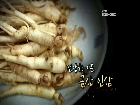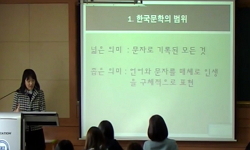The name of Byeolgok appeared in the history of literature when it was used in Sogyo and Kyeonggichega from the late Goryeo dynasty, and it was continuously and widely used in the title of various poetry throughout Joseon dynasty. However, as the name...
http://chineseinput.net/에서 pinyin(병음)방식으로 중국어를 변환할 수 있습니다.
변환된 중국어를 복사하여 사용하시면 됩니다.
- 中文 을 입력하시려면 zhongwen을 입력하시고 space를누르시면됩니다.
- 北京 을 입력하시려면 beijing을 입력하시고 space를 누르시면 됩니다.
부가정보
다국어 초록 (Multilingual Abstract)
The name of Byeolgok appeared in the history of literature when it was used in Sogyo and Kyeonggichega from the late Goryeo dynasty, and it was continuously and widely used in the title of various poetry throughout Joseon dynasty. However, as the name of Byeolgok was extensively used in literature genre with different features, there is a huge difficulty in clarifying the meaning of the Byeolgok and criteria for its name. There are two main points of view regarding the meaning of Byelgok. One view is that Byeolgok is a special song and opposite to the positive tune of court song, while another says byeolgok is a separated song made differently from the original one. Nevertheless, the exact meaning is still controversial. The extensive use of Byeolgok in the titles of different poetry(siga) indicates that the name is not based on the feature of genre. Thus, the different approach from the existing opinion would be uggested. The Byel means to leave necessary things after forceful division and removal of unnecessary elements from the united form combined with different features. The Gok means the sound of formal form made by combining specially fluctuation and relative length. It is advised that the meaning of Byeolgok with these two letters is replaced to the meaning of the flexible sound form by removing the “Gok” which is a rigid sound form. Therefore, Byeolgok is not a formal music categorized as court song, and it can be flexibly changed at a constant level according to singer ’s feeling or given situation. Literature with the name of Byeolgok is generally combined with a headword that represents spatial characteristics to name the title. It is strongly suggested that thistitle is closely related to sentiment of subjugated class whose physical space can hugely impact on their life. Thus, Byeolgok, which was widely used for the titles of poetry (siga) from the late Goryeo dynasty to Joseon dynasty, is the song without the rigid form of court song. It could be said that Byeolgok represents the song that expresses feeling-centered archetypal sentiment.
참고문헌 (Reference)
1 "禮記"
2 성호경, "한림별곡(翰林別曲)의 창작시기 논변" 일지사 56 : 1989
3 김선기, "한림별곡(翰林別曲)의 작자와 창작연대에 관한 고찰" 어문연구회 12 : 1983
4 조윤제, "한국시가사강" 을유문화사 1954
5 조동일, "한국문학의 갈래 이론" 집문당 1992
6 김학성, "한국고전시가의 연구" 원광대학교출판부 1980
7 김동욱, "한국가요의 연구" 을유문화사 1961
8 김사엽, "이조시대의 가요연구" 대양출판사 1956
9 김동욱, "연세대학교 팔십주년기념 논문집" 연세대학교 1965
10 손종흠, "속요 형식론" 박문사 2010
1 "禮記"
2 성호경, "한림별곡(翰林別曲)의 창작시기 논변" 일지사 56 : 1989
3 김선기, "한림별곡(翰林別曲)의 작자와 창작연대에 관한 고찰" 어문연구회 12 : 1983
4 조윤제, "한국시가사강" 을유문화사 1954
5 조동일, "한국문학의 갈래 이론" 집문당 1992
6 김학성, "한국고전시가의 연구" 원광대학교출판부 1980
7 김동욱, "한국가요의 연구" 을유문화사 1961
8 김사엽, "이조시대의 가요연구" 대양출판사 1956
9 김동욱, "연세대학교 팔십주년기념 논문집" 연세대학교 1965
10 손종흠, "속요 형식론" 박문사 2010
11 정병욱, "별곡의 역사적 형태고" 3 (3): 1955
12 김태준, "별곡의 기원"
13 이병기, "국문학전사" 민음사 1957
14 이익주, "고려말의 정치사회적 혼돈과 신흥사대부의 성장" 일조각 35 : 2004
15 이명구, "고려가요의 연구" 신아사 1974
16 성호주, "경기체가(景幾體歌)의 형성 연구" 제일문화사 1988
17 조동일, "경기체가(景幾體歌)의 장르적 성격" 학술원 15 : 1976
18 李滉, "退溪集"
19 "辭源"
20 段玉裁, "說文解字注"
21 "詩經"
22 "益齋亂藁"
23 李安訥, "東岳集"
동일학술지(권/호) 다른 논문
-
「地圖의 暗室」에 나타난 女性 - 여성, 주체화과정에 비춰진 대상
- 한국문학이론과비평학회
- 배선윤
- 2020
- KCI등재
-
- 한국문학이론과비평학회
- 전기화
- 2020
- KCI등재
-
「민옹전」의 쟁장설화(爭長說話) 수용 양상과 변용 의미
- 한국문학이론과비평학회
- 김순재
- 2020
- KCI등재
-
채만식의 「過渡期」에 투영된 뚜르게녜브(Тургенев)의 「전날밤」
- 한국문학이론과비평학회
- 임형모
- 2020
- KCI등재
분석정보
인용정보 인용지수 설명보기
학술지 이력
| 연월일 | 이력구분 | 이력상세 | 등재구분 |
|---|---|---|---|
| 2022 | 평가예정 | 재인증평가 신청대상 (재인증) | |
| 2019-01-01 | 평가 | 등재학술지 유지 (계속평가) |  |
| 2016-01-01 | 평가 | 등재학술지 선정 (계속평가) |  |
| 2015-12-01 | 평가 | 등재후보로 하락 (기타) |  |
| 2011-01-01 | 평가 | 등재학술지 유지 (등재유지) |  |
| 2009-01-01 | 평가 | 등재학술지 유지 (등재유지) |  |
| 2007-01-01 | 평가 | 등재학술지 유지 (등재유지) |  |
| 2004-01-01 | 평가 | 등재학술지 선정 (등재후보2차) |  |
| 2003-01-01 | 평가 | 등재후보 1차 PASS (등재후보1차) |  |
| 2001-07-01 | 평가 | 등재후보학술지 선정 (신규평가) |  |
학술지 인용정보
| 기준연도 | WOS-KCI 통합IF(2년) | KCIF(2년) | KCIF(3년) |
|---|---|---|---|
| 2016 | 0.68 | 0.68 | 0.69 |
| KCIF(4년) | KCIF(5년) | 중심성지수(3년) | 즉시성지수 |
| 0.69 | 0.68 | 1.285 | 0.21 |





 KCI
KCI KISS
KISS




